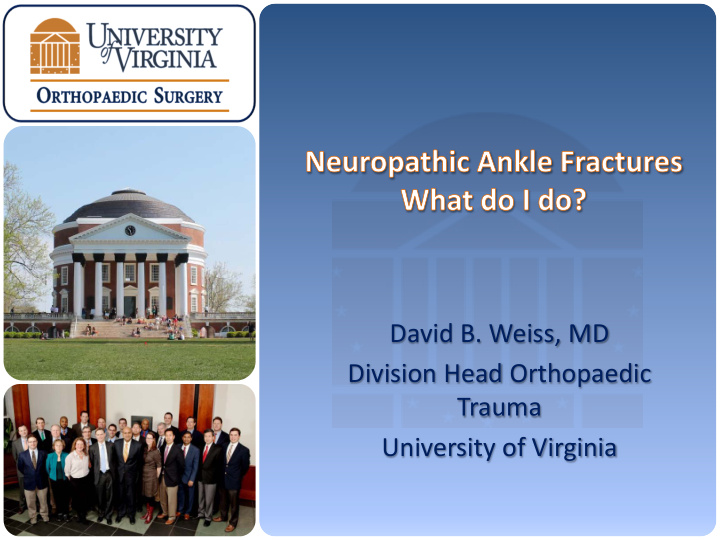



David B. Weiss, MD Division Head Orthopaedic Trauma University of Virginia
Disclosures • OTA- Education Committee • DepuySynthes- Consulting • Globus Medical- Consulting • AO North America- Teach Courses • Elsevier- Royalties • METRC- Site PI University of Virginia Orthopaedic Surgery
The Problem University of Virginia Orthopaedic Surgery
The Problem University of Virginia Orthopaedic Surgery
University of Virginia Orthopaedic Surgery
Neuropathy • Diabetes • Diabetes • Diabetes • But also can see in other medical conditions • Vasculopathy plays role in ability to heal University of Virginia Orthopaedic Surgery
Neuropathy • Can’t protect repair • No pain sensors to limit activity Louettafootandankle.com University of Virginia Orthopaedic Surgery
Options for treatment • Casting • CRPP • Ex-fix (circular vs uniplanar) • TTC Nail • ORIF plates and screws • Amputation (always a salvage option) University of Virginia Orthopaedic Surgery
Treatment • Ex-fix- – Need to have compliant patient – Uniplanar- long bars to limit weightbearing – Limited correction power – Circular/multi-planar • More complicated to apply • Needs frequent monitoring (pin loosening/infection) • Committed patient and surgeon (and office staff) • I use in obese- May allow some weight bearing University of Virginia Orthopaedic Surgery
TSF University of Virginia Orthopaedic Surgery
Treatment • TTC Nail – Good option if poor soft tissue envelope – May add biomechanical strength – Joint preparation limited (none?) – Compromise sub-talar (unaffected) joint – I use in elderly with pre-existing DJD or dementia University of Virginia Orthopaedic Surgery
TTC Nail University of Virginia Orthopaedic Surgery
Treatment • ORIF- plates and screws – Most familiar – Allows for anatomic reduction – Use larger plates and more screws – May also add trans-articular pins – Double time on immobilization/weight bearing restrictions – I use on most neuropathic ankles- esp if well controlled University of Virginia Orthopaedic Surgery
University of Virginia Orthopaedic Surgery
Post op University of Virginia Orthopaedic Surgery
Evidence Trans-articular steinman pins as adjuncts NWB 12 weeks Cast x 3 mos for wb Then AFO or appropriate inserts 13/15 successful University of Virginia Orthopaedic Surgery
Evidence Protected wb at 2 weeks in FAW/Cast retrospective 60% neuropathy, 33 % A1C >7 48 pts with ORIF- 25% complication rate. Overall relatively healthy group University of Virginia Orthopaedic Surgery
Rehab • Slow down rehab • Double the limitations time • Longer follow up to ensure healed/stable • Accept some HW breakage if stable University of Virginia Orthopaedic Surgery
What if disaster strikes? • Can always default to – Fusion with TTC nail or open fusion – BKA • Important to lay crepe early in treatment to set realistic expectations University of Virginia Orthopaedic Surgery
Summary • Challenging cases/patients • Need thorough eval and optimization of medical co-morbidities • Assume worst with fixation choices • Set expectations early • Know your limitations- refer to specialist if needed University of Virginia Orthopaedic Surgery
Questions/Discussion University of Virginia Orthopaedic Surgery
Recommend
More recommend